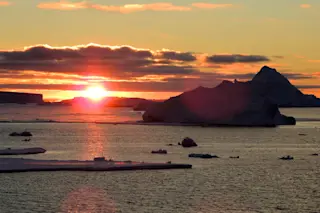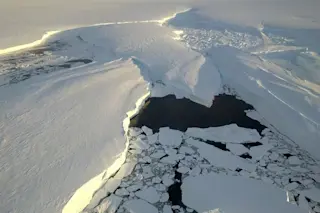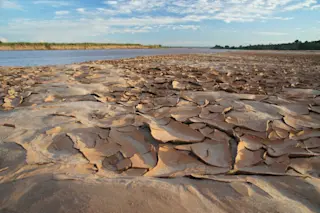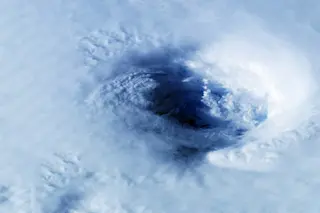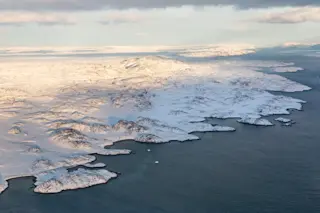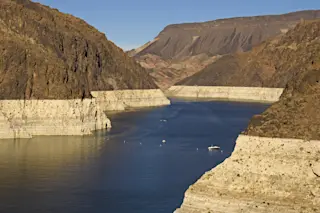The work of the Norwegian Young Sea Ice Cruise is providing insights into rapid Arctic changes caused by human-induced global warming
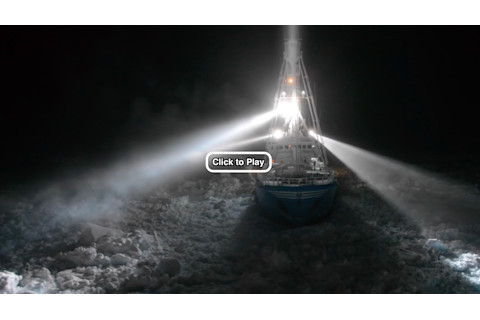
The research vessel Lance was frozen into the Arctic ice pack in the midst of the polar night in January 2015, under the auspices of Norwegian Polar Institute. The expedition, known as N-ICE2015, was launched to study the effects and feedbacks of the thinning of Arctic sea ice. (Source: Norwegian Polar Institute)
Note: This story was written by guest blogger, Zoë Rom, with contributions from me. Rom is a master's student at the University of Colorado's Center for Environmental Journalism, which I direct. She and I traveled to Tromsø, Norway together to cover the 2016 Arctic Frontiers Conference. This story is based in part on reporting Rom did while she was there.
"It was just another day at the office." That's how Mats Granskog of the Norwegian Polar Institute describes the work he did aboard a former sealing boat named the Lance after he and his colleagues
deliberately froze themselves into the Arctic sea ice near the North Pole in 2015. It was part of an expedition known as the Norwegian Young Sea Ice Cruise, or N-ICE2015.
With the Lance transformed into a modern research vessel, they carried out extensive scientific experiments using tons of equipment they unloaded onto the ice. During their sojourn, they endured weeks of darkness, roaring storms, roaming polar bears, and temperatures plunging below minus 40 degrees. Between January and June of 2015, the 69 researchers and 27 support crew members of the Lance also faced the risk that their “office” might disappear beneath their feet and crumble into the Arctic Ocean — a threat that turned out to be far from theoretical. This wasn’t the first time that Arctic explorers froze their boat into the sea ice to answer basic questions about its ebb and flow. And it probably will not be the last.The first such expedition was led by Norwegian explorer Fridtjof Nansen between 1893 and 1896. He and his crew attempted to reach the North Pole by drifting with the polar ice in their wooden boat, the Fram. They never made it to the Pole, but the expedition nonetheless was hailed as a scientific triumph — and Norwegians to this day regard Nansen as a national hero.In the modern era, the N-ICE2015 expedition was preceded by a project in 1997 called the Surface Heat Budget of the Arctic Ocean. As part of SHEBA, U.S. scientists froze their ship into the Arctic pack ice for 11 months.Now, planning is underway for another freeze-in. As part of the project, called MOSAiC, an even bigger group of scientists is planning to drift with the ice for a year, starting in 2019. If they secure the necessary funding, it would be the first year-round expedition into the central Arctic designed to explore the climate system.

Mats Granskog. Courtesy Norwegian Polar Institute What compels scientists to put themselves at such risk in the extreme cold of a months-long Arctic night? To find out, I spoke with Granskog, the chief scientist of N-ICE2015. We met in his office at the Norwegian Polar Institute during the Arctic Frontiers conference in Tromsø, Norway, last January.N-ICE2015 sought to answer basic questions about the ongoing transformation of the Arctic by human-caused climate change. Among them were these: What are the factors contributing to the dramatic melting of sea ice in the Arctic? How do snow and ice interact there? What happens to ice during intense winter storms? And what’s happening to surprisingly vibrant ecosystems associated with Arctic sea ice?To find answers, Granskog and his shipmates lodged the Lance into early winter ice in January 2015, and proceeded to go with the floe to study what happens to it — as Granskog puts it, “from cradle to grave.” Contrary to appearances, sea ice is not stationary. And as the N-ICE2015 scientists found out, the system turned out to be surprisingly dynamic — breaking, reforming, and flowing more than they had expected.
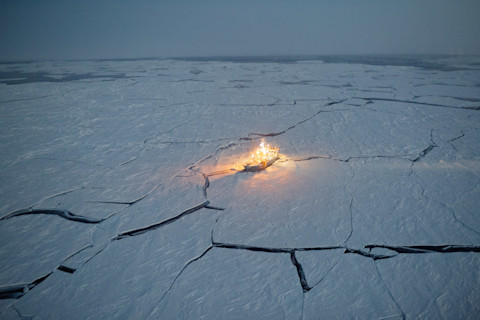
Leads in the Arctic sea ice can be seen separating ice floes from one-another in this photo shot from a helicopter as it was approaching the Lance. (Source: Nick Cobbing/Norwegian Polar Institute) The Lanceserved as the main research station from which Granskog and his team headed onto the ice to set up research platforms. To do their work, the crew used scooters, sheds, buoys, ice drills, a tent, a 10-meter-tall weather mast, and other equipment. For many weeks, they had to carry out this work in the totally sunless polar night. “You’re in a bubble, your whole world is the light on your ship, and on a day to day basis I didn’t think about survival,” Granskog recalls. “Maybe you forget the danger — which is a danger itself.” The darkness itself would have made their days at the office challenging enough. Having to work on the very fracture-prone ice heightened the risks even more. Three times, in fact, the ice shifted and broke up — twice when scientists were out on it — requiring them to scramble to collect sensitive scientific equipment and get back on the boat. Luckily, no one fell into the Arctic Ocean, and no one was hurt during these incidents.
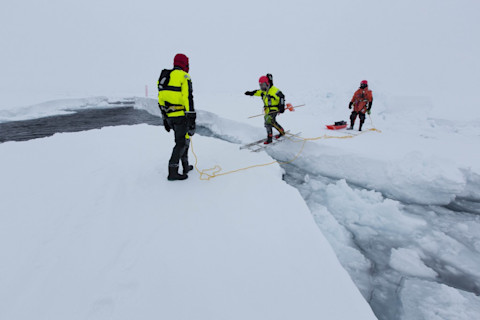
Researchers found the Arctic sea ice surprisingly prone to fracture. This photo of a scientist crossing an open lead using a ladder was taken on March 16, 2015, after light had returned to the sky. (Source: Tor Ivan Karlsen/Norwegian Polar Institute) The degree of ice instability came as something of a surprise to the team. “We had ice that was less than a meter and a half thick,” Granskog says. “In the old days, it would have been two and two and a half meters thick. We’ve lost quite a bit of the ice. It has dropped by half, roughly.” But It was not just the degree of change that was surprising. “It is amazing to see the pace of these changes,” he says. ”The pace is not at a geological time scale. It is happening at a human scale.” Not quite so surprising were the curious polar bears that showed up from time to time. On these occasions the scientists retreated back to the boat to avoid any unfortunate outcomes for themselves, and for the bears.
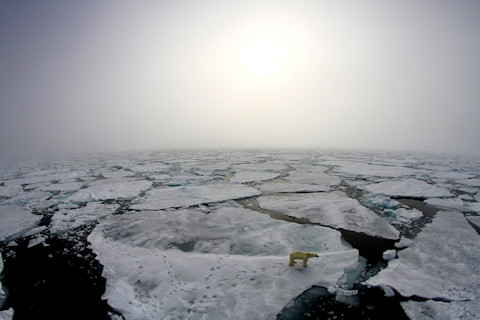
A curious polar bear checks out the Lance during the N-ICE2015 expedition. (Source: Marcos Porcires/Norwegian Polar Institute) He and his colleagues were willing to accept the risks inherent in their mission, unsure that this kind of scientific undertaking would be possible in the future. “There is an urgency, because things are changing so rapidly, and when a system is changing rapidly of course we need a new understanding,” Granskog says. Among the most obvious changes: As a result of a warming climate, less ice has been freezing in winter, and more has been melting in summer. The result: between 1972 and 2012, sea ice in parts of the central Arctic Ocean thinned from an average of 11.7 feet in 1975 to just 4.1 feet in 2012 — a 65 percent decrease.This thinner ice is also much younger on average than what once dominated the Arctic Ocean. Just three decades ago, ice at least several years old made up most of what was found in the region. Now, about 75 percent of winter sea ice in the Arctic is just a year old.Because it is younger and thinner, that ice melts more readily in summer than it once did. The result: The geographic extent of the Arctic’s floating sea ice cap is shrinking dramatically. The ten lowest minimum Arctic sea ice extents in the satellite record, which extends back to 1979, have all occurred since 2005.
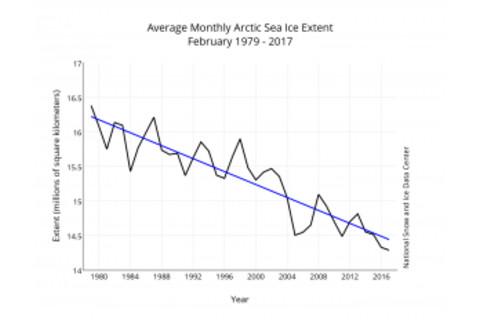
Monthly February Arctic ice extent for 1979 to 2017 shows a decline of 3 percent per decade. (Source: NSIDC) Now, not even winter sea ice is immune from the changes. In 2016, seven months saw record low sea ice extents — including the cold months of January, February, October and November, according to the National Snow and Ice Data Center
. That trend has continued into 2017, with Arctic sea ice extent this past February coming in as the lowest for the month on record.
Thanks to our emissions of carbon dioxide and other greenhouse gases, the average temperature of the Earth has been increasing. But the Arctic is warming twice as rapidly as the global average. More rapid warming in the Arctic was predicted a century ago, but the changes have been even more swift than forecast by computer models. The phenomenon is called “ Arctic amplification.” As temperatures rise, more and more Arctic sea ice melts during the warm summer season, leaving broader expanses of open ocean. Relatively dark ocean water reflects less than 10 percent of the solar energy that hits it, compared with about 85 percent for shiny ice and snow. That means most of the incoming solar energy is absorbed by the water, which warms up, helping to enhance the melting. And with more melting, more heat is stored in the ocean, setting up a positive feedback loop. That’s the broad picture, but many details are yet to be uncovered. Granskog and his colleagues hope data they collected on the N-ICE2015 expedition can help provide some insights to fill in the gaps in knowledge. The Arctic Ocean that he and his colleagues traveled through in 2015, anchored to sea ice, was far different from the one Fridtjof Nansen encountered in the Fram. In 1893, Nansen and his crew set out to explore the natural east-west flow of ice in the Arctic Ocean and reach the North Pole. After setting sail from the New Siberian Islands in the eastern end of the Arctic Ocean, the Framwas frozen into the pack ice and began to drift. After 18 months, Nansen and his companion Hjalmar Johansen set out with dogs and sleds to try to reach the North Pole. Although they didn’t achieve their goal, they traveled farther north than anyone else had been known to reach — to a latitude of 86°13.6′N.
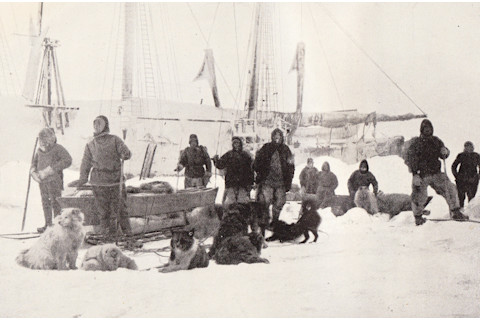
This photo, taken on March 14, 1895, shows crew members of the Fram helping Fridtjof Nansen and Hjalmar Johansen as they prepare to set off on a dog sled journey toward the North Pole. (Source: This photo was originally published in Fridjof Nansen's book, "Farthest North" published in 1897. It is now in the public domain and was accessed on Wikipedia on 3/7/17) Even with rudimentary scientific and navigational equipment, the Framexpedition produced a trove of knowledge about the Arctic. And it inspired other scientists to follow. On October 2, 1997, the SHEBA expedition began a year-long drift aboard the Canadian ice breaker Des Groseilliers in the Arctic Ocean. SHEBA’s researchers wanted to shed light on a relatively unknown factor in the Arctic climate: cloud cover. Do Arctic cloud variables increase or decrease in response to heat at Earth’s surface? Understanding this relationship was invaluable to improving climate models so they could do a better job of simulating what goes on in the Arctic region. SHEBA drifted with the pack ice from 75°N, 142°W to 80°N, 162°W with over 200 researchers on board. These intrepid scientists spent anywhere from a few days up to an entire year on board, battling high winds, low temperatures, unpredictable ice behavior, and, of course, polar bears.
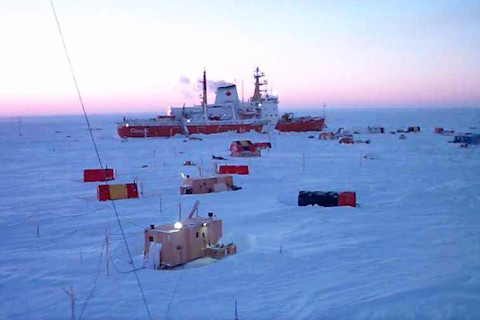
The Canadian icebreaker Des Groseilliers and the SHEBA Arctic sea ice camp in November, 1997. (Source: NASA GISS) SHEBA has helped scientists gain new insights into why Arctic sea ice is melting so rapidly. For example, using SHEBA data, NASA researchers found that persistent spring cloudiness, which tends to act like a blanket, trapping heat, causes average temperatures to rise. This helps to “move the ice closer to its melting temperature, even before the newly risen Sun is strong enough to matter,” writes Anthony Del Genio, one of the researchers. “Thus, more persistent clouds as spring approaches may cause the sea ice to first reach its melting temperature at an earlier date, and more frequent Arctic clouds in a warmer climate might accelerate sea ice decline.” Granskog’s N-ICE2015 expedition, following on from SHEBA, has helped lay scientific groundwork for the next project: The Multidisciplinary drifting Observatory for the Study of Arctic Climate, or “MOSAiC.” It is scheduled to set out in fall of 2019 with the goal of understanding the relationship between global climate change and the loss of sea ice, as well as improving climate modeling. Despite improvements, climate models still have difficulty simulating the Arctic climate system. They have, in fact, predicted less warming than has occurred there. MOSAiC, like its SHEBA and N-ICE predecessors, follows in Fram’sfootsteps by seeking to embed itself in the ice and drift. What’s different is its sheer scope and scale.MOSAiC scientists will live aboard the RV Polarstern for 12 months spanning 2019 and 2020. While operating from the ship, they will have support from aircraft, icebreakers, and satellite-linked research platforms capable of operating autonomously out on the ice away from the Polarstern. With a daily berthing rate of $1,600 dollars, and a budget exceeding $53 million, the planned voyage will be no small undertaking. The vast ship contains everything from working laboratories complete with deep freezers and a data analysis space to an academic style auditorium.
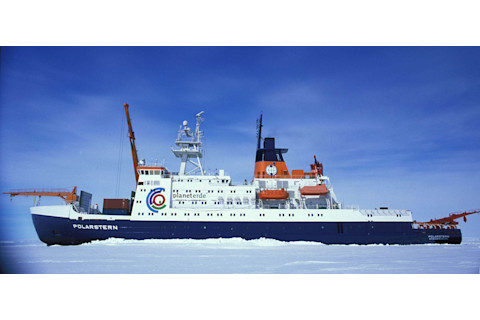
The German polar research vessel POLARSTERN in Atka Bay, Antarctica in 2002. (Source: Hannes Grobe, Alfred Wegener Institute via Wikimedia Commons) The most extensive project of its kind yet, MOSAiC may be the last chance for scientists to study Arctic sea ice and its associated ecosystems before the transformations now being wrought by climate change produce a new regime. “I feel that there’s an urgency to go out and do this before the ecosystem has completely changed to a different state,” Granskog says. And that might mean that the future of this particular brand of Arctic research is, in some ways, as uncertain as the ice it depends on. “You’re still walking on a thin piece of ice, and anything can happen,” Granskog says. “Not everything is under your control. Mother nature is in control.”



